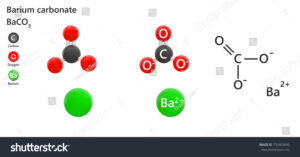BaCO3 Lewis structure delivers several internal facts about the Compound, which are quite relevant to provide a broad study about the chemical formation of inorganic Compounds. Almost 13 facts can be shared by the Lewis structure, which is being listed below:
- BaCO3 Lewis structure drawing
- BaCO3 Lewis structure resonance
- BaCO3 Lewis structure shape
- BaCO3 Lewis structure formal charge
- BaCO3 Lewis structure angle
- BaCO3 Lewis structure octet rule
- BaCO3 Lewis structure lone pairs
- BaCO3 valence electrons
- BaCO3 hybridization
- BaCO3 solubility
- BaCO3 ionic or covalent
- BaCO3 polar or nonpolar
- BaCO3 acidic or basic
BaCO3 Lewis structure drawing
The drawing procedure of Lewis structure is quite simple as it follows a systematic format to sketch the electronic structure of the Compounds. Lewis structure drawing becomes easy if the individual electronic Configuration of the elements can be identified initially.
In the case of drawing Lewis structure of BaCO3 that is Barium carbonate those simple steps would be followed. It is the fundamental need to calculate the number of valence electrons participates in the formation of Lewis structure of the Compound.
The above step would give the idea about the requirements of electrons in the elements to achieve the same electronic Configuration like nearest noble gases and an ultimate stability in the periodic table.

The next easy step is to find the electronegativity of the participated elements or atoms to identify that which element would earn the centre place in the Compound. It has been found that Ba wins in these criteria by having less electronegativity and smaller sixe than the carbonate ions (Combination of C and O).
After placing the centre atoms and calculating the number of bond pairs, the basic sketch of Lewis structure can be represented for Barium carbonate. While drawing this structure a knowledge about the internal electronic arrangement of the individual elements can also be gained.
BaCO3 Lewis structure resonance
Resonance refers to the Concept of alternating the bonds in the existence of one or more than one π bond in the Compounds. After drowning a Complete Lewis structure the number of σ and π bond present in the Compounds.
In BaCO3, carbonate ion hold a pair of π bond and σ bond with one oxygen n and two free electrons are present in another two oxygen atoms. Those two electrons have huge tendency to create π bond with carbon and giving alternative structure to the Compound. Therefore, the overall Barium carbonate Compound possesses a resonating value inside.
BaCO3 Lewis structure shape
Shape is one of the characteristic, which is properly defined by the Lewis structure drawn for the Compounds after sharing electrons with each other. Shape gives internal Constructive knowledge about any Compound.
The shape of BaCO3 is Contradictory, as it cannot be found with proper description. The arrangement of the elements is not that proper to expose definitive geometric shape for the Compound.
BaCO3 Lewis structure formal charge
BaCO3 is a ionic compound which is formed by the transfer of electrons therefore, the net charge of the compound cam be calculated by calculating the remaining charge in the compound after electro transfer take place completely. Net charge of BaCO3 is zero as Ba hold two cations, which is neutralised by two anions of carbonate in the formation of Barium carbonate.
BaCO3 Lewis structure angle
Bond angle is a physical characteristic of a compound which is indicated by Lewis structure of the compounds. After identifying the number of bond pairs and lone pairs the exact bond angle can be determined as those features have powerful effect on the bond angle of the compounds.
The bond angle of BaCO3 is the combination of two different ions. The carbonate has bond angle of 120° and this overall compound creates 90° angle with barium after making one sigma bind through electron transfer.
BaCO3 Lewis structure octet rule
Octet rule refers to the rule, which is followed by each of the periodic element to adopt the stable electronic Configuration like their nearest noble gas. Octet fulfilment stands for the process of fulfilling the last energy level of the atoms with filled number of electrons.
Octet rule drives the Compound to undergo electron sharing or transferring method. In BaCO3 Barium has been found to be existed as Ba+2 ion and it seeks for 2 electrons which have been donated by CO32- ion as it is clearly denoting that it has two extra electron in its structure.
In the case of fulfilling that configuration by gaining ultimate stability, the elements meet the octet rule and combines with each other.
BaCO3 Lewis structure lone pairs
Lewis structure denotes the number of lone pairs after predicting the number of bind pairs generated by the elements in the compound.
It has been recognised that in BaCO3 there is total eight lone pairs possessed by the three oxygen in the carbonate ion. Barium does not have any lone pair except a single electron after making bond with carbonate ion.
BaCO3 valence electrons
Valence electron refers to those electro which sexist in the last energy level of the elements and denotes the requirement of elections to fulfil octet.
In BaCO3, the number of valence electron is 4 as both barium and overall carbonate ion has two electrons to transfer. The transfer of the valance electrons from CO3 to Barium is the main feature hold by them in the formation of this new compound.
BaCO3 hybridization
Hybridization is one kind of characteristic of the compounds in chemistry which can be can be easily predicted by drawing Lewis structure and identifying the electronic transformation in between the elements.

The individual hybridisation of Barium and Carbonate can be predicted in this article. Ba holds sd hybridisation and CO3 holds sp2 hybridisation according to the electronic configuration. The combined hybridisation that is attained by Barium carbonate is sp3d.
BaCO3 solubility
Solubility is one of the property of the compounds which depends on the nature of being dissolved in polar or non-polar solvent for any compound. This concept is found to bring forth an intense impact on the idea about a compound.
BaCO3 is little soluble in water and acidic solutions. It means that BaCO3 slowly dissociates its ions in the polar solvent like water easily in the temperature of 25 °C , the solubility of BaCO3 in water is 24 mg/L at 25 °C. There is an exception, which express that sulphuric acid is not able to dissociate the compound.
BaCO3 ionic or Covalent
Ionic or Covalent nature can be defined by the representation of a specific process of electronic reaction between two elements. If the elements of a Compound shares electrons with each other them that Compound would be called Covalent and if the Complete transfer of electrons or ions can take place among them it would be called ionic.
The bond between Barium and Carbonate in BaCO3 is ionic by nature as there the complete transfer of ions takes place between Ba, the metal and CO3 the non-metal and a single sigma bond generated by that transfer.
BaCO3 polar or nonpolar
Polarity of a Compound depends on the geometric structure of a Compound. asymmetric structure with high bond pair bond pair repulsion is responsible for giving rise to the polarity in Compounds. Barium carbonate is a non-polar Compound. It has no electrical contraction on the internal structure that does not influence polarity in the compound.
BaCO3 acidic or basic
The amount of pH denotes the characteristics of a Compound by saying acidic or basic. When a compound possesses pH level more than 7 it considered as a basic compound,
Barium carbonate is basic in nature. As it has been predicted that the compound creates alkaline with water and holds pH level more than 7. It helps to neutralise acids by reacting as a base.
Summary
This article has been described as an informative hub about the facts regarding formation of an inorganic compound Barium carbonate. The BaCO3 Lewis structure has been drawn and utilised to identify several facts about the compound in this study.
Also Read:
- Co lewis structure
- Al3 lewis structure
- Asf5 lewis structure
- Cao lewis structure
- Ibr2 lewis structure
- Hf lewis structure
- Ba3n2 lewis structure
- Fecl2 lewis structure
- Nah lewis structure
- Mg3n2 lewis structure

Hi…..I am Sarnali Mukherjee, a graduate from the University of Calcutta. I love to teach and share knowledge on chemistry. I have gradually gained interest in article writing since one year ago. I would love to acquire more knowledge on my subject in the future.
Let’s connect through LinkedIn: